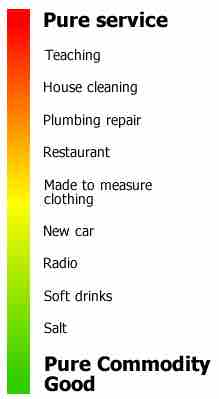Service operations are simply the application of operations management to an intangible good (i.e. a service). To understand how service operations function, let's first take a look at what is considered a service.

Service-Goods Continuum
This simple line graph shows industries that are nearly 100% service-related at the top and industries that are nearly 100% product-related at the bottom. It is an illustration of how the service-product continuum is more of a spectrum than a black and white rule.
Services Defined
An easy way to remember what a service is (compared to a product) is through using the '5 I's of Services':
- Intangibility - Services cannot be touched, shipped, handled, or looked at. They are an occurrence, not a tangible good.
- Inventory - Services cannot be stored for later use. They occur, or they do not occur.
- Inseparability - Services cannot be pulled into different parts or separated (as many tangible goods can be—which makes operations management quite different for products).
- Inconsistency - Services tend to be unique. A teacher may teach you a topic, and another teacher may teach you the same topic in another course. Each teacher will deliver this topic somewhat differently. This is a good example of service inconsistency.
- Involvement - Consumers are often directly involved in the service delivery. A therapist is a good example of this. The consumer is the center of the service, and thus each instance of the service is unique based on the individual involved.
Managing Service Operations
This definition offers a great deal of insight when applied to the concept of operational management. Without a tangible good to ship, handle and produce, operational managers are instead focused on the execution of an activity to fill a consumer need. This management of an instance is rather different than the management of a product.
Managing operations is just as critical on the service side as it is on the product side. While there are countless considerations to be made, many of which are unique to specific organizations or industries, these core operational decisions are strong indications of the mentality service management specialists consider:
Location
Choosing where to open a facility, how to lay out the facility, what size is appropriate, and overall how efficiently a given space can be used relative to the cost are key considerations. Consider a car mechanic opening a garage. Depending upon how many jobs she anticipates having within a given period of time, and how many employees she expects to be able to manage simultaneously, she may want to open a facility with three garages or five garages. It really depends on how much output she expects she can accomplish, and how much input demand will provide.
Scheduling
Just as a product manufacturing facility will know when a product will be where, so too do service operators need to know when a given service should start and what duration of time is required to complete it. Maximizing output through planning properly can minimize opportunity costs and maximize revenue, and plays an integral role in operational management of services. Take a doctor's office. If they simply had everyone come in whenever they wanted, there would be times when the staff would have nothing to do (but be obligated to be there, and be paid), and other times when there would be too much to do and capital and customers would be lost.
Quality
As the '5 I's of Services' indicate, most services tend to be completely unique. A hair dresser rarely gives the same haircut twice and, even if they do, it would be cut to fit a different individual. As a result, managing for high quality output is rather complex. Each execution is measured relative to the specific instance and that specific consumer, making tools like NPS surveys and other measures of individual satisfaction highly useful in optimizing. Following these ratings, operational specialists must consider the comments received and work to find a way to integrate this feedback into future services.